Can You Lay a Water Heater on Its Side?
Author: Omar Alonso | Editor: Omar Alonso
Review & Research: Jen Worst & Chris Miller

Can you lay a water heater on its side when transporting it? Or will it damage the appliance? In short, yes. You can pull it off, but you'll need the right strategy to ensure it arrives safely at your destination. Transporting the water heater upright is always better, but if you have a truck with an immovable canopy, that's not an option.
As long as you prep the heater properly, take care when loading it, and drive safely, you shouldn't have any problems. This post gives you everything you need to know about transporting a water heater on its side.
What's the Issue with Transporting a Water Heater?
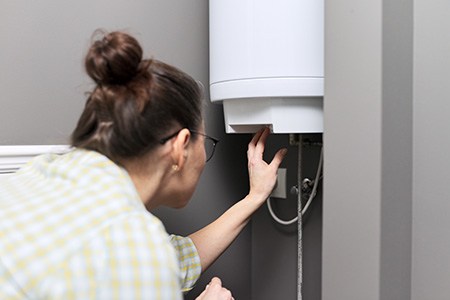
So, what's the issue with transporting a water heater on its side anyway? What difference does it make over vertical transportation? The water heater's interior features a thin glass lining, and compressing it during transport – especially if you hit a bump while driving, can crack or shatter the liner.
Using effective padding and securing the heater using ratchet straps gets your heater to your destination in one piece. Most water heaters come with a control panel on one side, and you'll need to ensure the control panel faces up during transportation.
The anode and dip tube protruding from the top of the water heater is fragile, and it's best to remove them before transportation. Above all, make sure you take it easy on the drive. Slamming into a pothole or going too fast over a speed bump leads to disaster.
Transporting a tank type of water heater is only half the battle. These appliances can easily weigh over 100 lbs., and stand up to 5 feet tall. So, you'll need someone to help you load and unload it, or you'll drop it or hurt yourself, resulting in a cracked liner and a stiff back.
Preparing a Water Heater for Transport
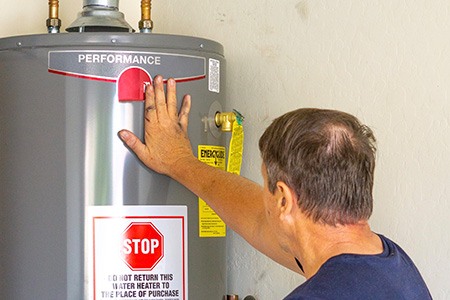
If you fail to prepare, you prepare to fail. The task of transporting the water heater starts with prepping the appliance for safe movement. Follow these steps to ensure the safe preparation of the unit before moving it to the truck.
1) Turn Off the Unit
Start with turning off the gas supply to the unit. Flip the gas control valve to the off position and turn off the gas supply. Next, turn off the main gas line by turning the knob on the valve to the perpendicular position. Parallel means it's on.
2) Disconnect the Water Heater From the Gas Line
After the gas is off, look at the line. You'll notice a large and a small nut. You'll need two different wrenches to loosen them. Hold the small nut with one wrench and use the other to loosen the large nut. (Apply forces in different directions; remember – “righty tighty, lefty loosey”.
3) Cap the Gas Line
Wind some Teflon plumbers tape around the threads of the gas line and shut it off with a pipe cap. Tighten the cap using the wrench. The PTFE tape ensures an airtight seal and no gas leaks out.
4) Remove the Flexible Gas Line From the Heater
You'll notice a flexible line connecting the gas line to the water heater – Remove it from the unit.
5) Drain the Water Tank
Turn off the water supply line to the tank. Open the hot water faucets in every room in the house until the water goes cold. Fit a garden hose to the drain valve on the heater to ensure you completely empty the tank. If you encounter issues with the water heater not filling up, check out this information.
6) Disassembly of Certain Parts
You'll need to disassemble and prep the unit for transport by unhooking the temperature and pressure relief valve and the hot and cold water pipes. You'll find these pipes on the top of the heater. If you have copper pipes, you must cut them before pulling out the unit. Remove the vent pipe on the top of the heater.
If you have an electrical water heater, you'll follow the same steps but don't have to worry about disconnecting it from the gas. Unplug the unit and ensure you wind up the electrical cord into a neat loop, then tape it to the side of the appliance to ensure it doesn't drag on the floor during transportation.
That's it – Prep is done, and you're ready to move the water heater to your vehicle. Once you get it home, you'll find it won't take long to install the water heater.
Transporting a Water Heater
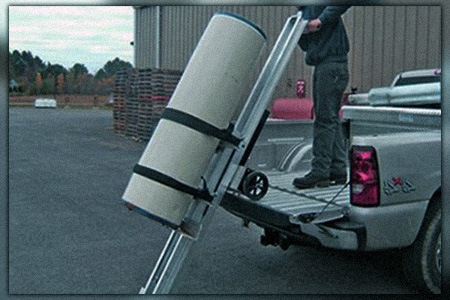
Can you lay a water heater on its side during transport? This is where things get a little tricky. The anode rod, dip tube, and glass lining are incredibly fragile. Take the utmost care when moving the water heater around. Don't be a hero and try and move it yourself; you'll likely fold under the weight, lose your grip on the unit, and drop it – cracking the liner.
Water heaters can weigh anywhere from 150 to 200 lbs., so it's a challenging task for one person to handle. Find a friend that owes you a favor and call it out. Here's a step-by-step guide to safely moving the water heater to the truck.
1) Check the Heater Will Fit in the Vehicle
The last thing you need is to get the heater to the truck, only to find it doesn't fit in the load bay. Before you start the prep work for transport, take a measuring tape and size up the entry point to the load bay on your vehicle.
2) Protect the Casing & Glass Liner
Padding is your friend. Secure furniture pads around the heater's steel casing using masking or duct tape. Ensure you have more furniture pads on the truck's load bay bed.
The more padding, the better the protection and the less chance of the glass liner cracking. If you don't have any furniture pads on hand, thick blankets or quilts are the next best option. This glass lining can crack even years later, so don't worry. Just turn off the water heater and use the water, it simply won't be hot but will still work.
3) Protect the Pipes & Controls
Face the pipes and control panel away from the floor and sides of the dolly when moving the unit and placing it in the load bay. As mentioned, remove the dip tube and anode before transporting and loading the heater.
Wrap the dip tube and anode in bubble wrap and tape them up before transport. Leave them in the truck's cab with you, not in the load bay in the back. Don't break the controls or jingle them around as you'll find yourself with thermopile voltage low warnings and more.
4) Don't Hurt Yourself
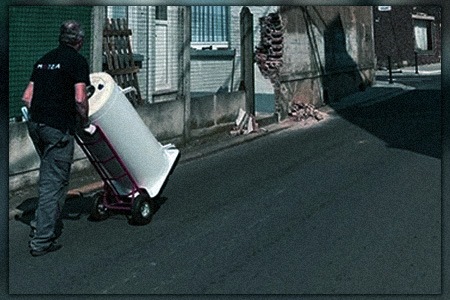
Remember to lift with your knees – not your back. It's a heavy load to bear, even with two people. Ensure you have a good grip on the unit when transferring it to the dolly and the truck.
5) Transporting the Water Heater Using a Dolly
A hand truck or dolly is a lifesaver when moving the water heater around. After loading the heater on the dolly, secure it in place using racket straps. You're looking for a tight fit, but don't over-tighten, as you'll flex the casing and crack the liner.
6) Transfer the Water Heater to the Vehicle
Tilt the dolly towards you when moving it, and let the wheels do the work. Take extra special care if you're navigating stairs. Dropping it on a stair might crack the liner.
Have your assistant stand in front of the dolly, grab the bottom bar, and gently drop it down the stairs, one by one, in a controlled manner.
Pull back on the dolly handles when traversing stairs to get you a controlled descent down the staircase.
7) Drive Carefully & Slowly
Release the ratchet strap and load the heater onto the truck, placing it on more furniture pads or blankets. If there are eyes around the interior of the load bay, use your ratchet straps to secure the heater in place and prevent it from moving around while driving.
Finally – drive carefully on the way to your destination. Take it easy when traversing speed bumps, and watch out for potholes on your journey. Don't make fast, sharp turns that could cause the heater to shift in the load bay.
Can You Transport a Water Heater on its Side? The Key Takeaways
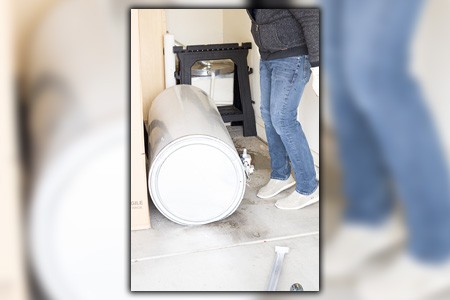
Let’s cover the main points from above to help you remember what you’ve learned:
- If possible, transporting items like water heaters and fridges should always be done with the unit standing upright.
- Sometimes you can't transport the water heater in the vertical position, especially if you have a truck with a canopy over the load bay.
- Measure the opening to the load bay to ensure it accommodates the unit. Remember to compensate for the width of the padding.
- Prep the water heater properly for transport. Remove the anode and dip tube before placing it on the dolly.
- Position the water heater on the dolly and in the load bay with the control panel facing away from the rear of the dolly or the sides and floor of the load bay. Ensure the pipes don't face a sidewall of the load bay when loading it into the tuck.
- Use ratchet straps to secure the heater in place on the dolly and in the load bay of the truck.
- Drive carefully en route to your destination. Avoid potholes, go slowly over speed bumps, and don't make fast turns.
- Make sure you lift with your back when moving the water heater around.
- Get a friend to help you. Trying to move the unit around by yourself will likely result in a drop and a loss of the water heater and your money.
That’s it. Now let me tell you a personal story. The question is can you haul a new electric water heater on its side.
Can You Lay a Water Heater on its Side? You Should Avoid It
My brother needed my help to purchase a water heater and we pulled it off the shelf at the big box store and laid it on its side gently. The teenage cashier told us we had ruined the water heater by laying it on it’s side, we must buy it, and there could be no refunds. This was because “the mercury will have spilled out of the top of the thermometer.”
Needless to say, we carefully loaded it into the back of the truck, still on it’s side, and secured it. I rode in the back to keep it even more secure, and then we got it home and let it ride on a dolly down a big flight of stairs into the basement. And guess what years later? The water heater works perfectly fine.
There’s a lot of myths and old wives’ tales regarding the question “can you lay a water heater on its side” and the answer is you can but if you can avoid it you should. It’s risky due to interior parts banging around or the sides flexing and shattering the inner glass lining. That’s the real reason. Transport the water heater on its side at your own risk. I’ve done it successfully. Just ask yourself if the risk is worth it.



